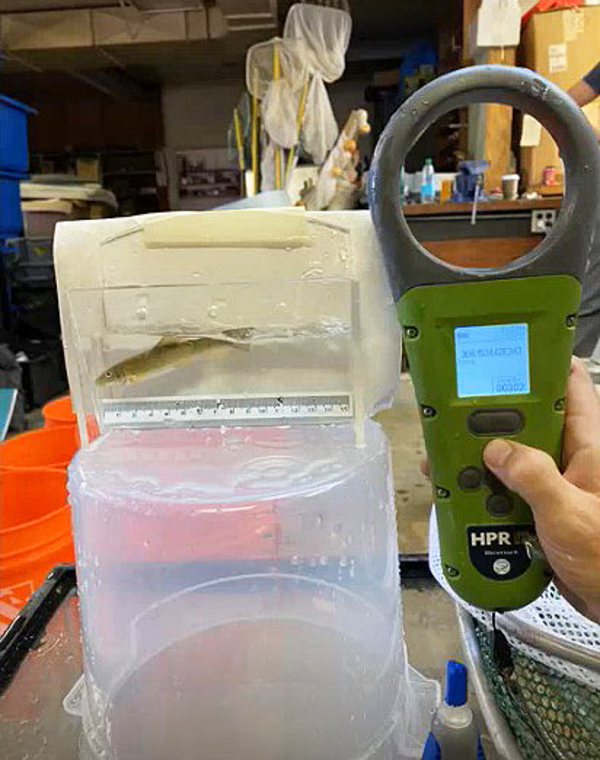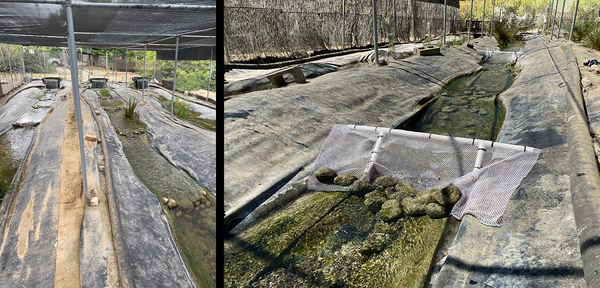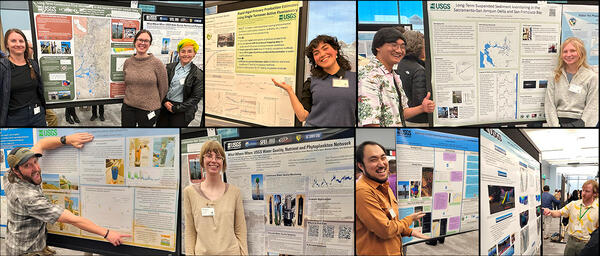This photo shows a passive integrated transponder (PIT) tag reader being used to test a tagged Santa Ana Sucker.
Steve Ackley
Steve Ackley - Public Affairs Specialist - California Water Science Center
After serving a term as an Information Specialist for the California Water Science Center from 2018 to July of 2022, Steve returned as a Public Affairs Specialist in 2023. Prior to coming to the USGS, Steve worked in corporate marketing for 20+ years. Before that, he was a high school English teacher.
Professional Experience
Public Affairs Specialist
U.S. Geological Survey (USGS), Sacramento, CA
Jan 2023 - Present
Information Specialist
U.S. Geological Survey (USGS), Sacramento, CA
Jan 2018 - July 2022
Web/Digital Content Producer/Developer
Power Integrations, San Jose, CA
May 2008 - Jan 2018
Project Manager for Apple Education Website (consultant)
Apple Computer, Cupertino, CA
Education and Certifications
San Francisco State University - MA (Education)
Bethany University - BA (Communications)
Science and Products
Non-USGS Publications**
**Disclaimer: The views expressed in Non-USGS publications are those of the author and do not represent the views of the USGS, Department of the Interior, or the U.S. Government.
USGS Participates in 2021 Orange County Youth Environmental Summit
USGS Participates in Earth Day Festivities on Alcatraz Island
This photo shows a passive integrated transponder (PIT) tag reader being used to test a tagged Santa Ana Sucker.
The above photos show raceways at the Riverside Corona Resource Conservation District (RCD) facility.
The above photos show raceways at the Riverside Corona Resource Conservation District (RCD) facility.
The photo shows members of the research team. From left to right: Tevin Bui (RCD), Jordan Buxton (USGS), Brett Mills (RCD), Alicia Ruan (RCD), and Brock Huntsman (USGS). Inset at right are Marissa Wulff (top) and Jeff Gronemyer (bottom), both of the USGS.
The photo shows members of the research team. From left to right: Tevin Bui (RCD), Jordan Buxton (USGS), Brett Mills (RCD), Alicia Ruan (RCD), and Brock Huntsman (USGS). Inset at right are Marissa Wulff (top) and Jeff Gronemyer (bottom), both of the USGS.
CAWSC poster presenters at 2025 IEP Workshop. Clockwise from upper left: Anna Conlen, Elise Shea, Lex Thomas, Zoё Siman-Tov, Bryan Gopez, Emma Walker, David Hart, Maura Uebner, Lawrence Fujiwara, Trevor Violette.
CAWSC poster presenters at 2025 IEP Workshop. Clockwise from upper left: Anna Conlen, Elise Shea, Lex Thomas, Zoё Siman-Tov, Bryan Gopez, Emma Walker, David Hart, Maura Uebner, Lawrence Fujiwara, Trevor Violette.
CAWSC Biogeochemistry group at 2025 IEP Workshop. Left to Right: Back Row - Maura Uebner, Keith Bouma-Gregson, Kyle Leathers; Middle Row - Crystal Sturgeon, Zoё Siman-Tov, Lane Bratz, Emily Richardson, Tamara Kraus, Alex Ryan; Front Row - Nick Framsted
CAWSC Biogeochemistry group at 2025 IEP Workshop. Left to Right: Back Row - Maura Uebner, Keith Bouma-Gregson, Kyle Leathers; Middle Row - Crystal Sturgeon, Zoё Siman-Tov, Lane Bratz, Emily Richardson, Tamara Kraus, Alex Ryan; Front Row - Nick Framsted

Active (or moving) camera footage of Santa Ana Sucker (Pantosteus santaanae). Cameras were attached to “selfie sticks” and walked up and down the raceways (or fabricated streams).
Active (or moving) camera footage of Santa Ana Sucker (Pantosteus santaanae). Cameras were attached to “selfie sticks” and walked up and down the raceways (or fabricated streams).

An open-source image recognition program was used to detect the fish and lures in the videos. The program was “trained” to recognize the fish and lures by exposing it to approximately 800 images of fish and non-fish.
An open-source image recognition program was used to detect the fish and lures in the videos. The program was “trained” to recognize the fish and lures by exposing it to approximately 800 images of fish and non-fish.

Sample map - Legacy Mercury Contamination in California’s Sierra Nevada. This map show locations of remediation efforts.
Sample map - Legacy Mercury Contamination in California’s Sierra Nevada. This map show locations of remediation efforts.

Historical photo of the Malakoff Diggins hydraulic gold mine in the Sierra Nevada in California.
Historical photo of the Malakoff Diggins hydraulic gold mine in the Sierra Nevada in California.
 Legacy Mercury Contamination from Historical Gold Mining
Legacy Mercury Contamination from Historical Gold Mining
Mercury contamination from historic gold mining represents a potential risk to human health and the environment. There is a lack of public awareness of the history mercury use in gold mining and how it contributed to this situation, and also what the present concerns are. Specifically, the public is not aware of locations and levels of contamination.
Mercury contamination from historic gold mining represents a potential risk to human health and the environment. There is a lack of public awareness of the history mercury use in gold mining and how it contributed to this situation, and also what the present concerns are. Specifically, the public is not aware of locations and levels of contamination.

Photo of members of the team associated with USGS research done in collaboration with UC Davis.
linkThe above photo includes members of the team associated with research done in collaboration with UC Davis. From left to right, Angela DePalma-Dow (Lake County, conference co-organizer), Sergio Valbuena (UC Davis), Charles Alpers (USGS), Alicia Cortes (UC Davis), and Samantha Sharp (UC Davis).
Photo of members of the team associated with USGS research done in collaboration with UC Davis.
linkThe above photo includes members of the team associated with research done in collaboration with UC Davis. From left to right, Angela DePalma-Dow (Lake County, conference co-organizer), Sergio Valbuena (UC Davis), Charles Alpers (USGS), Alicia Cortes (UC Davis), and Samantha Sharp (UC Davis).
USGS scientists attaching solar panel and antennae to soil moisture response unit.
USGS scientists attaching solar panel and antennae to soil moisture response unit.
Panorama of area near Squirrel Creek soil moisture response unit installation in California's Feather River watershed.
Panorama of area near Squirrel Creek soil moisture response unit installation in California's Feather River watershed.
A team member helps dig the pit for the soil moisture sensors in the Plumas National Forest in California. Inset: close-up of soil removed from Squirrel Creek pit.
A team member helps dig the pit for the soil moisture sensors in the Plumas National Forest in California. Inset: close-up of soil removed from Squirrel Creek pit.
Soil moisture sensors positioned in pit at different depths. Inset: close-up of sensor showing the two probes that gather the data.
Soil moisture sensors positioned in pit at different depths. Inset: close-up of sensor showing the two probes that gather the data.
Shown clockwise from top left are: 1] setting up mast to support the station components, 2] installing data logging and transmitting equipment, 3] attaching solar panel and antennae, 4] finished assembly.
Shown clockwise from top left are: 1] setting up mast to support the station components, 2] installing data logging and transmitting equipment, 3] attaching solar panel and antennae, 4] finished assembly.

Soil monitoring station installation team, with personnel from USGS and USDA, at Squirrel Creek installation site.
Soil monitoring station installation team, with personnel from USGS and USDA, at Squirrel Creek installation site.

USGS Hydrologist Jim Howle checks data logging and transmission components using a laptop computer.
USGS Hydrologist Jim Howle checks data logging and transmission components using a laptop computer.

USGS team in front of Squirrel Creek monitoring station in California's Plumas National Forest.
USGS team in front of Squirrel Creek monitoring station in California's Plumas National Forest.
Lilium pardalinum, or California Tiger Lillies, found along Squirrel Creek in the Plumas National Forest.
Lilium pardalinum, or California Tiger Lillies, found along Squirrel Creek in the Plumas National Forest.
Lilium pardalinum, or California Tiger Lillies, found along Squirrel Creek in the Plumas National Forest.
Lilium pardalinum, or California Tiger Lillies, found along Squirrel Creek in the Plumas National Forest.
Legacy Mercury Contamination from Historical Gold Mining
Science and Products
Non-USGS Publications**
**Disclaimer: The views expressed in Non-USGS publications are those of the author and do not represent the views of the USGS, Department of the Interior, or the U.S. Government.
USGS Participates in 2021 Orange County Youth Environmental Summit
USGS Participates in Earth Day Festivities on Alcatraz Island
This photo shows a passive integrated transponder (PIT) tag reader being used to test a tagged Santa Ana Sucker.
This photo shows a passive integrated transponder (PIT) tag reader being used to test a tagged Santa Ana Sucker.
The above photos show raceways at the Riverside Corona Resource Conservation District (RCD) facility.
The above photos show raceways at the Riverside Corona Resource Conservation District (RCD) facility.
The photo shows members of the research team. From left to right: Tevin Bui (RCD), Jordan Buxton (USGS), Brett Mills (RCD), Alicia Ruan (RCD), and Brock Huntsman (USGS). Inset at right are Marissa Wulff (top) and Jeff Gronemyer (bottom), both of the USGS.
The photo shows members of the research team. From left to right: Tevin Bui (RCD), Jordan Buxton (USGS), Brett Mills (RCD), Alicia Ruan (RCD), and Brock Huntsman (USGS). Inset at right are Marissa Wulff (top) and Jeff Gronemyer (bottom), both of the USGS.
CAWSC poster presenters at 2025 IEP Workshop. Clockwise from upper left: Anna Conlen, Elise Shea, Lex Thomas, Zoё Siman-Tov, Bryan Gopez, Emma Walker, David Hart, Maura Uebner, Lawrence Fujiwara, Trevor Violette.
CAWSC poster presenters at 2025 IEP Workshop. Clockwise from upper left: Anna Conlen, Elise Shea, Lex Thomas, Zoё Siman-Tov, Bryan Gopez, Emma Walker, David Hart, Maura Uebner, Lawrence Fujiwara, Trevor Violette.
CAWSC Biogeochemistry group at 2025 IEP Workshop. Left to Right: Back Row - Maura Uebner, Keith Bouma-Gregson, Kyle Leathers; Middle Row - Crystal Sturgeon, Zoё Siman-Tov, Lane Bratz, Emily Richardson, Tamara Kraus, Alex Ryan; Front Row - Nick Framsted
CAWSC Biogeochemistry group at 2025 IEP Workshop. Left to Right: Back Row - Maura Uebner, Keith Bouma-Gregson, Kyle Leathers; Middle Row - Crystal Sturgeon, Zoё Siman-Tov, Lane Bratz, Emily Richardson, Tamara Kraus, Alex Ryan; Front Row - Nick Framsted

Active (or moving) camera footage of Santa Ana Sucker (Pantosteus santaanae). Cameras were attached to “selfie sticks” and walked up and down the raceways (or fabricated streams).
Active (or moving) camera footage of Santa Ana Sucker (Pantosteus santaanae). Cameras were attached to “selfie sticks” and walked up and down the raceways (or fabricated streams).

An open-source image recognition program was used to detect the fish and lures in the videos. The program was “trained” to recognize the fish and lures by exposing it to approximately 800 images of fish and non-fish.
An open-source image recognition program was used to detect the fish and lures in the videos. The program was “trained” to recognize the fish and lures by exposing it to approximately 800 images of fish and non-fish.

Sample map - Legacy Mercury Contamination in California’s Sierra Nevada. This map show locations of remediation efforts.
Sample map - Legacy Mercury Contamination in California’s Sierra Nevada. This map show locations of remediation efforts.

Historical photo of the Malakoff Diggins hydraulic gold mine in the Sierra Nevada in California.
Historical photo of the Malakoff Diggins hydraulic gold mine in the Sierra Nevada in California.
 Legacy Mercury Contamination from Historical Gold Mining
Legacy Mercury Contamination from Historical Gold Mining
Mercury contamination from historic gold mining represents a potential risk to human health and the environment. There is a lack of public awareness of the history mercury use in gold mining and how it contributed to this situation, and also what the present concerns are. Specifically, the public is not aware of locations and levels of contamination.
Mercury contamination from historic gold mining represents a potential risk to human health and the environment. There is a lack of public awareness of the history mercury use in gold mining and how it contributed to this situation, and also what the present concerns are. Specifically, the public is not aware of locations and levels of contamination.

Photo of members of the team associated with USGS research done in collaboration with UC Davis.
linkThe above photo includes members of the team associated with research done in collaboration with UC Davis. From left to right, Angela DePalma-Dow (Lake County, conference co-organizer), Sergio Valbuena (UC Davis), Charles Alpers (USGS), Alicia Cortes (UC Davis), and Samantha Sharp (UC Davis).
Photo of members of the team associated with USGS research done in collaboration with UC Davis.
linkThe above photo includes members of the team associated with research done in collaboration with UC Davis. From left to right, Angela DePalma-Dow (Lake County, conference co-organizer), Sergio Valbuena (UC Davis), Charles Alpers (USGS), Alicia Cortes (UC Davis), and Samantha Sharp (UC Davis).
USGS scientists attaching solar panel and antennae to soil moisture response unit.
USGS scientists attaching solar panel and antennae to soil moisture response unit.
Panorama of area near Squirrel Creek soil moisture response unit installation in California's Feather River watershed.
Panorama of area near Squirrel Creek soil moisture response unit installation in California's Feather River watershed.
A team member helps dig the pit for the soil moisture sensors in the Plumas National Forest in California. Inset: close-up of soil removed from Squirrel Creek pit.
A team member helps dig the pit for the soil moisture sensors in the Plumas National Forest in California. Inset: close-up of soil removed from Squirrel Creek pit.
Soil moisture sensors positioned in pit at different depths. Inset: close-up of sensor showing the two probes that gather the data.
Soil moisture sensors positioned in pit at different depths. Inset: close-up of sensor showing the two probes that gather the data.
Shown clockwise from top left are: 1] setting up mast to support the station components, 2] installing data logging and transmitting equipment, 3] attaching solar panel and antennae, 4] finished assembly.
Shown clockwise from top left are: 1] setting up mast to support the station components, 2] installing data logging and transmitting equipment, 3] attaching solar panel and antennae, 4] finished assembly.

Soil monitoring station installation team, with personnel from USGS and USDA, at Squirrel Creek installation site.
Soil monitoring station installation team, with personnel from USGS and USDA, at Squirrel Creek installation site.

USGS Hydrologist Jim Howle checks data logging and transmission components using a laptop computer.
USGS Hydrologist Jim Howle checks data logging and transmission components using a laptop computer.

USGS team in front of Squirrel Creek monitoring station in California's Plumas National Forest.
USGS team in front of Squirrel Creek monitoring station in California's Plumas National Forest.
Lilium pardalinum, or California Tiger Lillies, found along Squirrel Creek in the Plumas National Forest.
Lilium pardalinum, or California Tiger Lillies, found along Squirrel Creek in the Plumas National Forest.
Lilium pardalinum, or California Tiger Lillies, found along Squirrel Creek in the Plumas National Forest.
Lilium pardalinum, or California Tiger Lillies, found along Squirrel Creek in the Plumas National Forest.















